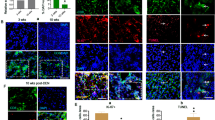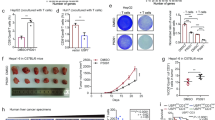Abstract
Fas (CD95) is a receptor involved in induction of apoptotic cell death of Fas-bearing cells, including hepatocytes1,2 and T cells3. Injection of Fas-specific antibodies into mice leads to fulminant hepatic failure and death1. Fas also transduces growth-promoting signals in proliferating T cells4,5, fibroblasts6 and some tumor cells7. Here we show that partial hepatectomy, which triggers the immediate onset of liver regeneration8, protected mice against the lethal effects of Fas-specific antibodies and prevented hepatocyte apoptosis in response to Fas engagement in vivo. Furthermore, Fas engagement accelerated liver regeneration after partial hepatectomy. Liver regeneration kinetics were delayed in mutant mice with decreased cell surface Fas expression (lpr mice9). In contrast, regeneration was not delayed in lpr-cg mutant mice, which have a Fas mutation that prevents Fas-induced death10 but not Fas-dependent proliferative stimulation. Our results indicate that Fas engagement on cells in regenerating or healing tissues may promote cell growth.
This is a preview of subscription content, access via your institution
Access options
Subscribe to this journal
Receive 12 print issues and online access
$209.00 per year
only $17.42 per issue
Buy this article
- Purchase on Springer Link
- Instant access to full article PDF
Prices may be subject to local taxes which are calculated during checkout


Similar content being viewed by others
References
Osagawara, J. et al. Lethal effects of the anti-Fas antibody in mice. Nature 364, 806–809 (1993).
Lacronique, V. et al. Bcl-2 protects from lethal hepatic apoptosis induced by an anti-Fas antibody in mice. Nature Med. 2, 80–86 (1996).
Nagata, S. & Golstein, P. The Fas death factor. Science 267, 1449–1456 (1995).
Alderson, M.R. et al. Fas transduces activation signals in normal human T lymphocytes. J. Exp. Med. 178, 2231–2235 (1993).
Desbarats, J., Wade, T., Wade, W.F. & Newell, M.K. Dichotomy between naïve and memory CD4+ T cell responses to Fas (CD95) engagement. Proc. Natl. Acad. Sci. USA 96, 8104–8109 (1999).
Freiberg, R.A. et al. Fas signal transduction triggers either proliferation or apoptosis in human fibroblasts. J. Invest. Dermatol. 108, 215–219 (1997).
Owen-Schaub, L.B., Meterissian, S. & Ford, R.J. Fas/APO-1 expression and function on malignant cells of hematologic and non-hematologic origin. J. Immunotherapy 14, 234–241 (1993).
Michalopoulos, G.K. & DeFrances, M.C. Liver regeneration. Science 276, 60–66 (1997).
Adachi, M., Watanabe-Fukunaga, R. & Nagata, S. Aberrant transcription caused by the insertion of an early transposable element in an intron of the Fas antigen gene of lpr mice. Proc. Natl. Acad. Sci. USA 90, 1756–1760 (1993).
Kimura, M. & Matsuzawa, A. Autoimmunity in mice bearing lpr.cg: a novel mutant gene. Int. Rev. Immunol. 11, 193–210 (1994).
Higgins, G.M. & Anderson, R.M. Experimental pathology of the liver. Arch. Pathol. 12, 186–202 (1931).
Irmler, M. et al. Inhibition of death receptor signals by cellular FLIP. Nature 388, 190–195 (1997).
Rafaeli, Y., Van Parijs, L., London, C.A., Tschopp, J. & Abbas, A.K. Biochemical mechanisms of IL-2 regulated Fas-mediated T cell apoptosis. Immunity 8, 615–623 (1998).
Sata, M. & Walsh, K. Endothelial cell apoptosis induced by oxidized LDL is associated with the down-regulation of the cellular caspase inhibitor FLIP. J. Biol. Chem. 273, 33103–33106 (1998).
Tzung, S.-P., Fausto, N. & Hockenbery, D.M. Expression of Bcl-2 family during liver regeneration and identification of Bcl-x as a delayed early response gene. Am. J. Pathol. 150, 1985–1995 (1997).
Sneller, M.C. et al. A novel lymphoproliferation/autoimmune syndrome resembling murine lpr/gld disease. J. Clin. Invest. 90, 334–341 (1992).
Sato, Y. et al. Activation of extrathymic T cells in the liver during liver regeneration following partial hepatectomy. Immunology 78, 86–91 (1993).
Albrecht, J.H., Hoffman, J.S., Kren, B.T. & Steer, C.J. Changes in cell-cycle associated gene expression in a model of impaired liver regeneration. FEBS Lett. 347, 157–162 (1994).
Galle, P.R. et al. Involvement of the CD95 (APO-1/Fas) receptor and ligand in liver damage. J. Exp. Med. 182, 1223–1230 (1995).
Kondo, T., Suda, T., Fukuyama, H., Adachi, M. & Nagata, S. Essential role of the Fas ligand in the development of hepatitis. Nature Med. 3, 409–413 (1997).
Yamada, Y., Webber, E.M., Kirillova, I., Peschon, J.J. & Fausto, N. Analysis of liver regeneration in mice lacking type 1 or type 2 tumor necrosis factor receptor: requirement for type 1 but not type 2 receptor. Hepatology 28, 959–970 (1998).
Bradham, C.A., Plumpe, J., Manns, M.P., Brenner, D.A. & Trautwein, C. Mechanisms of hepatic toxicity: TNF-induced liver injury. Am. J. Physiol. 275, 387–392 (1998).
Hikawa, N., Kiuchi, Y., Maruyama, T. & Takenaka, T. Delayed neurite regeneration and its improvement by nerve growth factor (NGF) in dorsal root ganglia from MRL-lpr/lpr mice in vitro. J. Neurol. Sci. 149, 13–17 (1997).
Biancone, L. et al. Development of inflammatory angiogenesis by local stimulation of Fas in vivo. J. Exp. Med. 186, 147–152 (1997).
Desbarats, J., Duke, R.C. & Newell, M.K. Newly discovered role for Fas ligand in the cell-cycle arrest of CD4+ T cells. Nature Med. 4, 1377–1381 (1998).
Acknowledgements
We thank S. Huber for animal care; S. Mischler and P.W. Nevin for advice on surgical technique; J. Kupperman, J. Rogers and J.E. Stone for technical assistance; C. Charland for flow cytometry assistance; J.Q. Russell, M.W. Roe and S. Lidofsky for advice on hepatocyte preparations; D. Davis for assistance with histology; and R.J. Melamede and S. Lidofsky for reviewing the manuscript. This research was supported by grant number 1RO1GM62562 from the National Institutes of Health, a postdoctoral fellowship from the Medical Research Council of Canada (J.D.), research support from the University of Vermont, and sponsored research from Immune Response Corporation, Carlsbad, California.
Author information
Authors and Affiliations
Corresponding author
Rights and permissions
About this article
Cite this article
Desbarats, J., Newell, M. Fas engagement accelerates liver regeneration after partial hepatectomy. Nat Med 6, 920–923 (2000). https://doi.org/10.1038/78688
Received:
Accepted:
Issue Date:
DOI: https://doi.org/10.1038/78688
This article is cited by
-
Liver regeneration: biological and pathological mechanisms and implications
Nature Reviews Gastroenterology & Hepatology (2021)
-
Highlight report: caspase 8 as a therapeutic target in chronic liver disease
Archives of Toxicology (2019)
-
Fas-L promotes the stem cell potency of adipose-derived mesenchymal cells
Cell Death & Disease (2018)
-
CD95 ligand induces senescence in mismatch repair-deficient human colon cancer via chronic caspase-mediated induction of DNA damage
Cell Death & Disease (2017)
-
Mice lacking functional CD95-ligand display reduced proliferation of the intestinal epithelium without gross homeostatic alterations
Medical Molecular Morphology (2016)



